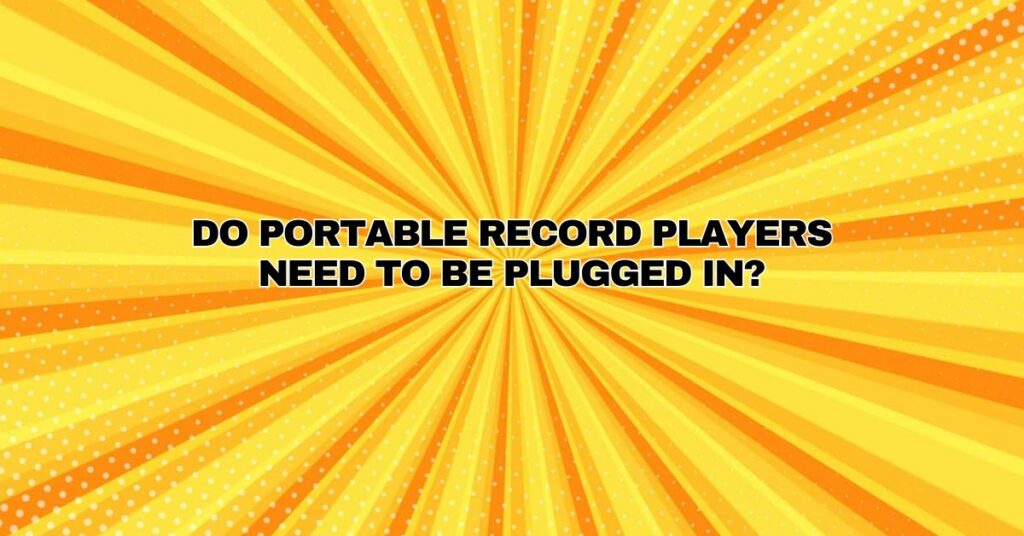Portable record players, also known as turntables or record players, have become increasingly popular among music enthusiasts and vinyl collectors. These compact and user-friendly devices offer the convenience of playing vinyl records almost anywhere. One common question that arises regarding portable record players is whether they need to be plugged in to operate. In this comprehensive guide, we will explore the power requirements of portable record players and how they function, providing a clear understanding of their power sources and usage.
Part 1: Understanding Portable Record Players
Before addressing their power sources, it’s crucial to understand what portable record players are and how they work.
1.1 What Are Portable Record Players?
Portable record players are compact and self-contained turntable units designed for ease of transport and convenience. They are equipped with all the necessary components for playing vinyl records, including a turntable, tonearm, cartridge, and built-in speakers. This self-contained design allows users to play records without the need for external audio equipment, such as amplifiers or speakers.
1.2 Key Features of Portable Record Players
- Built-In Speakers: Portable record players come with built-in speakers, allowing users to listen to vinyl records without connecting external speakers.
- Battery-Powered: Many portable record players are designed to operate on batteries, making them truly portable and suitable for outdoor use or on-the-go listening.
- AC Power: In addition to battery power, some portable record players also offer the option to plug into an AC power source for continuous playback.
Part 2: Power Sources for Portable Record Players
Portable record players can be powered by various sources, and the power requirements may differ depending on the model and brand. Here are the primary power sources for portable record players:
2.1 Battery-Powered Portable Record Players
- Internal Batteries: Some portable record players come equipped with built-in rechargeable or replaceable batteries. These batteries provide the necessary power to operate the turntable and speakers without the need for external power sources.
- Benefits: Battery-powered portable record players offer exceptional mobility and versatility. They can be used in locations where AC power may not be readily available, such as outdoor settings, picnics, or even during travel.
- Charging: If your portable record player has rechargeable batteries, you’ll need to charge them when they run low. Charging is typically done via a power adapter or USB cable.
2.2 AC-Powered Portable Record Players
- Power Adapter: Many portable record players come with an AC power adapter that allows you to plug the turntable into a standard electrical outlet. The adapter provides a continuous source of power for both the turntable and the built-in speakers.
- Benefits: AC-powered portable record players offer the advantage of uninterrupted playback without worrying about battery life. They are suitable for home use, parties, or extended listening sessions.
2.3 Dual-Powered Portable Record Players
- Hybrid Design: Some portable record players are designed to offer both battery-powered and AC-powered options. This dual-powered design provides users with flexibility and convenience.
- Benefits: Dual-powered portable record players allow you to choose between battery operation for portability and AC power when you have access to an electrical outlet. This versatility caters to a variety of usage scenarios.
Part 3: Do Portable Record Players Need to Be Plugged In?
The need to plug in a portable record player depends on the power source and your specific preferences:
3.1 Battery-Powered Portable Record Players
Battery-powered portable record players do not need to be plugged in while in battery mode. They are designed for cordless, on-the-go listening. However, it’s important to monitor battery life and recharge or replace batteries as needed to ensure uninterrupted playback.
3.2 AC-Powered Portable Record Players
AC-powered portable record players require an electrical outlet and, consequently, need to be plugged in when used in this mode. This provides continuous power for both the turntable and the built-in speakers.
3.3 Dual-Powered Portable Record Players
Dual-powered portable record players offer the flexibility to choose between battery or AC power. When plugged in using the AC adapter, they are not reliant on batteries and can be used continuously.
Part 4: Tips for Using Portable Record Players
Whether you opt for a battery-powered or AC-powered portable record player, here are some tips for using them effectively:
- Battery Maintenance: If your portable record player uses batteries, make sure to recharge or replace them as needed to prevent interruptions during playback.
- Volume Control: Adjust the volume to your desired level using the onboard controls. Some models may also have tone control options.
- Maintenance: Regularly clean the stylus (needle) using a stylus brush and clean your records with a carbon-fiber or anti-static brush to maintain optimal sound quality.
- Proper Storage: When not in use, store your portable record player in a safe and dry location. Keep it protected from dust and potential damage.
Conclusion
In conclusion, portable record players offer the versatility and convenience of playing vinyl records in various settings, and their power requirements depend on the model and your specific needs. Battery-powered portable record players are perfect for on-the-go listening, while AC-powered models are ideal for uninterrupted playback at home. Dual-powered portable record players provide the best of both worlds, giving you the flexibility to choose between battery and AC power. Whether you prefer the mobility of battery operation or the reliability of AC power, portable record players offer a delightful way to enjoy the classic sound of vinyl records virtually anywhere.


